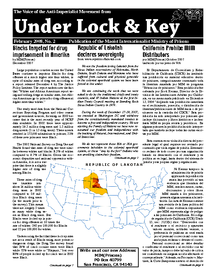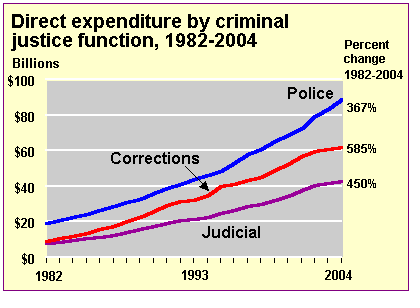
California Prohibe MIM Distributors
El Departamento de Correciónes y Rehabilitación de Califonria (CDCR) ha instituido una prohibición en material educativo dentro de prisiones, categoricamente censurando toda la literatura mandada por MIM su programa “Educacion de prisionero.” Esta prohibición fue ordenada por Scott Kernan, Director de la Division de las Instituciones Adultas por California, en un memoranda publicado en Diciembre 13, 2006 “dirijiendo una prohibición inmediata en el recibimiento, poseción, o distribución de literatura/publicaciones de MIM hacia o de prisioneros en la custodia del CDCR.” Esta prohibición ha sido interpretado por prisiones que incluye dicionarios y libros históricos e incluso hasta MIM su propia revista y periódicos. En algunas prisones la prohibición ha sido interpretada que también incluye todas las cartas escritas por MIM.
Esta censura es en violación directa del precedente legal el qual requiere ser revisado por contenido que viola reglas de prisión. Sistematico rechaso de todo correo por una organización basado en desacuerdo con el remitente y su política no es legal, hasta dentro del sistema de prisión y sus propias reglas y regulaciones.
Ni Kernan tampoco la administración de prisión applicando la prohibición nunca han proveido ni una evidencia que literatura del MIM, muchos menos, cartas, diccionarios y otros libros MIM manda a los prisioneros, presenta alguna amenaza a la institución. La carta de Kernan contiene una revisión de la linea politica del MIM como evidencia suponiendo que MIM representa algo de peligro a las prisiones de California. El codigo de regulación de California (CCR) Titulo 15, sec: 3135(b) dice: “Descuerdos con el remitente o el recivicor y aparentes valores morales, actitudes verazes, o preferencia de palabras no será usada por el personal correccional como una razón para rechazar o detener el correo. Personal correccional no debe desafiar o confrontar el remitente o al recividor con tal valor de juicia, tampoco debe tal valor de critica ser considerado en ninguna acción afectando el correspondiente.” Además, en Procunier v. Martinez, la Corte Sumprema sostuvo el derecho de prisioneros de recibir correo, sin importar la opinión del oficial de prisión en el contenido del correo, mientras no ahiga restricciones legitimas de la prisión relacionado con propositos correcionales.
Hay una fuerte correlación entre educación y aprisionamiento. De acuerdo con el Buro de Estatísticas de Justicia (el Departamento de Justicia de Estados Unidos y su propia organización) el más reciente estudio de 1997 de información de población, 41% de prisiones de estado y federales no han completado preparatoria. Esto comparado con 18% de la población general 18 y mayores. (1) Las cosas se miran aun peor entre prisioneros edad 29 hasta 39 demostrando que la inclinación es hacia mas prisoneros sín una educación de preparatoria como prisoneros más jovenes están aun menos educados que las prisioneros mayores. Otros estudios más recientes han enseñado que esta inclinación continúa. La probabilidad de terminar en una prisión es tremendamente más alto para jóvenes de raza negra quienes paran de atender la escuela antes de obtener un diploma de preparatoria. Y un titulo coleguial es más protección contra el aprisionamiento.
En el otro lado de la educación, programas de educación dentro de prisión han repetidamente estado enseñando que reduce el reofendimiento ayudando los prisioneros a encontrar trabajos y oportunidades cuando ellos son puestos en libertad. Estudios individuales y metalicos repetidamente concluyeron lo mismo.
Desde 1990, la literature ha mostrado que prisioneros quienes atienden programas educacionales mientras ellos están encarcelados son menos probable de retornar a prisión después de su salida. Estudios en varios estados ha indicado que en promedio 24% ha desminuido donde han recibido una educación apropiada. Además, la clase correcta de programs educacionales lleva hacia menos violencia por los presos envueltos en los programas y un ambiente prisionero más positivo. (2)
California ya tiene uno de los más altos porcentaje de reofensa en el país, con un inmenso 70% de prisioneros en libertad terminando para atras en prisión dentro de tres años. Y en años recientes nosotros hemos visto que programas de educación, visitación, y hasta correo recortado, asi los prisioneros son dejados con muy poco que hacer detrás de las barras y virtualmente un imposible trabajo de ir derecho de prisión hacia las calles sin una educación o servicios transicional.
Implementando una prohibición por todo el estado de material educativo del MIM es una manera más de mantener los prisioneros encarcelados. Prisioneros quienes leen nuestra literatura frequentamente nos dicen que ellos aprenden a canalizar su tiempo dentro de actividades productivos en vez de participar en violencia detrás de las barras. Y la educación ayuda ellos a tener una mejor oportunidad de estarse en las calles una vez ellos son puestos en libertad. Nosotros recibimos cartas preguntando por material que leer como esta todo el tiempo: “Soy un prisionero del estado en el Valle Salinas y estoy en una yarda que ha estado en encierro constantemente por aproximadamente cuatro años. Por eso me encuentro sin poder llegar a la librería aquí. He leido cada panfleta. Estaría muy agradecido por cualquier clase de libro cuberita suave que puedan mandar. Cualquier cosa que tu mandes sera leido y releido por bastantes prisioneros.” Seguramente el CDC”R” sabe que allá hay una demanda de material para leer en la prisión, pero ellos ni siquiera se molestan en llenar este vacio con novelas de pelusa. Ellos prefieron gastar su gran paquete en salarios más altos para sus brutales guardias y defensa legal de sus actividades ilegales tal como crear pleitos como deporte.
Claro, el CDCR tiene razones en prohibir el MIM a los prisioneros. Educar los prisioneros es contrario a sus metas. Con la educación viene la conciencia, y mientras los prisoneros trabajan con MIM reporta que evitan enfrentasiones violentas (con los dos, sus semejantes y los guardias), también ellos son más probables a tomar apelaciones legales y administrativas, y de educar y organizar sus propios compañeros prisioneros para levantarse por sus derechos legales. Como un prisionero de California nos escribió en octubre del año pasado:
Extendiendo mis respetos hacia todos, me gustaría tambien expresar de todo corazón mi agradecimiento a todo aquel que trabaja, trabajando con y/o afiliado con el Movimiento Internacional Maoista por todo lo que ustedes hacen y el servicio que proveen. Especialmente, con respeto a las prisioneros. Hablando de experiencia personal yo puedo decir que recibiendo y leyendo tus boletines, es las dos cosas, una mayor motiviación y fomentación. Decir que tus Notas MIM me ha servido bien no cubre nada en especifico, pero puedo decir que tus notas han sido un potente ingrediente hacia mi transformación: y tu programa de libros gratis para prisioneros me ha criado y alimentado como un pequeño en los pechos de su madre. Los libros que tu me has mandato tan generosamente, me han enseñando a respetar y valorar la importancia de una educación… una educación que me ha enseñado que con el conocimiento viene enorme responsibilidad. La responsibilidad que surgue de no solo saber la diferiencia entre lo que se dice ser bien, o mal, probando y deseifrando, verdades y mentiras, pero sabiendo y actuando en acuerdo con lo que es consistente y progresivo en el ejercicio de determinación personal y defensa personal.
Nosotros continuarámos persiguiendo el pleito contra esta prohibición en California, trabajando sercamente con nuestras compañeros detras de las barras para disputar esta acción en corte si es necesario. Nosotros animamos el CDCR liderazgo y los politicos del estado de California a levantarse hacia adelante y derrocar esta prohibición ilegal antes de ellas ser forzados a desperdiciar dinero sin necesidad en una batalla legal que solamente expondrá sus despreocupaciones para la reabilitación, el bienestar de prisioneros, y los propias leyes ellos afirman sostener.
Necesitamos ayuda de prisioneros en este batalla, y el suporto de la gente afuera para parar esta prohibición. Manda cartas de protesta a: James Tilton, Secretary, California Department of Corrections and Rehabilitation, 1515 S. Street, Sacramento, CA 95184.
Notas:
1. Buro Estatistico de Justicia de Reporte Especial:
Educacion y Poblacion Correccional, Enero 2003.
2. Boletin
Correccional de educacion, v55 n4, p.297-305, December 2004. Tambien
mira “La Nacion” Marzo 4, 2005. Estudios han demostrado que
participantes en educación de prisión, vocación y programas de trabajo
tienen una tendencia en promedio de 20-60 porciento mas bajos que esos
sin participar. Otro reciente estudio mayor de prisioneros encontro que
los participantes en programs de educación fueron 29 porciento menos
probable de terminar para atras en la carcel, y que los participantes
ganaraon salarios mas altos despues de su salida.





 Download printable PDF
Download printable PDF



